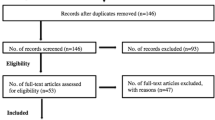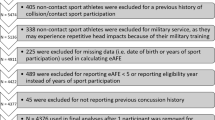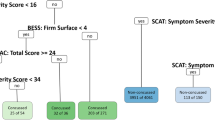Abstract
Background
Sport-related concussion and repetitive head impact exposure in contact sports continue to receive increased attention in public and medical spheres. The Concussion Assessment, Research and Education (CARE) Consortium, a multicenter cooperative, was established to study the natural history of concussion in National Collegiate Athletic Association (NCAA) collegiate student-athletes across 29 colleges and universities in the United States. The purpose of this investigation is to provide normative data from the CARE Consortium and evaluate for differences between sport categories.
Methods
NCAA student-athletes were evaluated annually for general demographics and sport-specific characteristics before the start of the competitive season. We collected demographic and medical history information and evaluated each student-athlete’s neurocognitive function, neurological status, postural stability, and self-reported symptoms. Sports were categorized by the amount of contact typically associated with the sport (i.e., contact, limited contact, non-contact). Comparisons between the three sport categories for the evaluated variables were made using linear or zero inflated negative binomial regression models adjusted for gender, concussion history, and household income.
Results
Over a 2-year period (August 2014–July 2016), 15,681 NCAA athletes completed preseason evaluations. Overall, 53% of the athletes were in the contact sport group, 31% were in the limited contact group and 17% were in the non-contact group. After adjusting for covariates, there were statistically significant differences found between athlete groups, although the differences and effect sizes were small and not clinically significant. The contact sport group had better scores on Immediate Post-Concussion Assessment Testing (ImPACT®) visual and verbal memory, Sport Concussion Assessment Tool (SCAT) symptom checklist, and Brief Symptom Inventory–18 (BSI-18), but slower ImPACT reaction time and worse scores on Standardized Assessment of Concussion (SAC). Further, the data indicate that some ImPACT score distributions were noticeably different from those presented in the technical manual.
Conclusions
In this large, racially and socio-economically diverse cohort of male and female college athletes, we found no evidence that student-athletes participating in contact sports have clinically meaningful deficits in pre-season cognitive and balance testing. They also did not report significantly more symptoms of psychological distress when compared with student-athletes in non-contact or limited contact sports. In addition, the data suggest potential limitations when using published ImPACT norms when evaluating injured athletes.


Similar content being viewed by others
References
Broglio SP, Cantu RC, Gioia GA, et al. National athletic trainers’ association position statement: management of sport concussion. J Athl Train. 2014;49(2):245–65.
Giza CC, Kutcher JS, Ashwal S, et al. Summary of evidence-based guideline update: evaluation and management of concussion in sports: Report of the Guideline Development Subcommittee of the American Academy of Neurology. Neurology. 2013;80(24):2250–7.
Harmon KG, Drezner J, Gammons M, et al. American Medical Society for Sports Medicine position statement: concussion in sport. Clin J Sport Med. 2013;23(1):1–18.
Langlois JA, Rutland-Brown W, Wald MM. The epidemiology and impact of traumatic brain injury: a brief overview. J Head Trauma Rehabil. 2006;21(5):375–8.
McCrory P, Meeuwisse WH, Aubry M, et al. Consensus statement on concussion in sport: the 4th International Conference on Concussion in Sport held in Zurich, November 2012. J Am Coll Surg. 2013;216:e55–71.
Broglio SP, Puetz TW. The effect of sport concussion on neurocognitive function, self-report symptoms and postural control : a meta-analysis. Sports Med. 2008;38(1):53–67.
Cameron KL, Marshall SW, Sturdivant RX, Lincoln AE. Trends in the incidence of physician-diagnosed mild traumatic brain injury among active duty U.S. military personnel between 1997 and 2007. J Neurotrauma. 2012;29(7):1313–21.
McCrea M, Barr WB, Guskiewicz KM, et al. Standard regression-based methods for measuring recovery after sport-related concussion. J Int Neuropsychol Soc. 2005;11:58–69.
Matheson GO, Shultz R, Bido J, Mitten MJ, Meeuwisse WH, Shrier I. Return-to-play decisions: are they the team physician’s responsibility? Clin J Sport Med. 2011;21(1):25–30.
LaRoche AA, Nelson LD, Connelly PK, Walter KD, McCrea MA. Sport-related concussion reporting and state legislative effects. Clin J Sport Med. 2015;26(1):33–9.
McCrea M, Hammeke T, Olsen G, Leo P, Guskiewicz K. Unreported concussion in high school football players: implications for prevention. Clin J Sport Med. 2004;14(1):13–7.
Broglio SP, McCrea M, McAllister T, et al. A national study on the effects of concussion in collegiate athletes and US Military Service Academy Members: the NCAA-DoD Concussion Assessment, Research and Education (CARE) Consortium Structure and Methods. Sports Med. 2017:0707–0701.
ImPACT Applications Inc. Immediate post-concussion assessment testing (ImPACT®) test—online version 2007–2012. Pittsburgh, PA. 2011, pp. 1–59.
Barr WB. Methodologic issues in neuropsychological testing. J Athl Train. 2001;36:297–302.
McCrea M. Standardized mental status testing on the sideline after sport-related concussion. J Athl Train. 2001;36(3):274–9.
McCrea M, Kelly JP, Kluge J, Ackley B, Randolph C. Standardized assessment of concussion in football players. Neurology. 1997;48(3):586–8.
McCrea M, Kelly JP, Randolph C, et al. Standardized assessment of concussion (SAC): on-site mental status evaluation of the athlete. J Head Trauma Rehabil. 1998;13(2):27–35.
Guskiewicz KM, Ross SE, Marshall SW. Postural stability and neuropsychological deficits after concussion in collegiate athletes. J Athl Train. 2001;36(3):263–73.
McCrory P, Meeuwisse WH, Aubry M, et al. Consensus statement on concussion in sport: the 4th International Conference on Concussion in Sport held in Zurich, November 2012. J Am Coll Surg. 2013;216(5):e55–71.
Meachen SJ, Hanks RA, Milils SR, Rapport LJ. The reliability and validity of the brief symptom inventory-18 in persons with traumatic brain injury. Arch Phys Med Rehabil. 2008;89(5):958–65.
Rice SG, American Academy of Pediatrics Council on Sports Medicine and Fitness. Medical conditions affecting sports participation. Pediatrics. 2008;121(4):841–8.
Hintze JL, Nelson RD. Violin plots: a box plot-density trace synergism. Am Stat. 1998;52(2):181–4.
Covassin T, Swanik CB, Sachs M, et al. Sex differences in baseline neuropsychological function and concussion symptoms of collegiate athletes. Br J Sports Med. 2006;40(11):923–7.
Covassin T, Elbin R, Kontos A, Larson E. Investigating baseline neurocognitive performance between male and female athletes with a history of multiple concussion. J Neurol Neurosurg Psychiatry. 2010;81(6):597–601.
Ulfarsson T, Lundgren-Nilsson A, Blomstrand C, Nilsson M. A history of unemployment or sick leave influences long-term functioning and health-related quality-of-life after severe traumatic brain injury. Brain Inj. 2014;28(3):328–35.
Loeys T, Moerkerke B, De Smet O, Buysse A. The analysis of zero-inflated count data: beyond zero-inflated Poisson regression. Br J Math Stat Psychol. 2012;65(1):163–80.
Kerr ZY, Marshall SW, Guskiewicz KM. Reliability of concussion history in former professional football players. Med Sci Sports Exerc. 2012;44(3):377–82.
Kerr ZY, Mihalik JP, Guskiewicz KM, Rosamond WD, Evenson KR, Marshall SW. Agreement between athlete-recalled and clinically documented concussion histories in former collegiate athletes. Am J Sports Med. 2015;43(3):606–13.
Robbins CA, Daneshvar DH, Picano JD, et al. Self-reported concussion history: impact of providing a definition of concussion. Open Access J Sports Med. 2014;5:99–103.
Guskiewicz KM, McCrea M, Marshall SW, et al. Cumulative effects associated with recurrent concussion in collegiate football players: the NCAA concussion study. JAMA. 2003;290(19):2549–55.
ImPACT Applications Inc. ImPACT Version 2.0 clinical user’s manual. Pittsburgh, PA, pp. 1–71.
Lichtenstein JD, Moser RS, Schatz P. Age and test setting affect the prevalence of invalid baseline scores on neurocognitive tests. Am J Sports Med. 2014;42(2):479–84.
Schmidt JD, Register-Mihalik JK, Mihalik JP, Kerr ZY, Guskiewicz KM. Identifying Impairments after concussion: normative data versus individualized baselines. Med Sci Sports Exerc. 2012;44(9):1621–8.
Covassin T, Elbin RJ, Bleecker A, Lipchik A, Kontos AP. Are there differences in neurocognitive function and symptoms between male and female soccer players after concussions? Am J Sports Med. 2013;41(12):2890–5.
Kaplan GA, Turrell G, Lynch JW, Everson SA, Helkala EL, Salonen JT. Childhood socioeconomic position and cognitive function in adulthood. Int J Epidemiol. 2001;30(2):256–63.
Kontos AP, Elbin RJ 3rd, Covassin T, Larson E. Exploring differences in computerized neurocognitive concussion testing between African American and White athletes. Arch Clin Neuropsychol. 2010;25(8):734–44.
Zimmer A, Piecora K, Schuster D, Webbe F. Sport and team differences on baseline measures of sport-related concussion. J Athl Train. 2013;48(5):659–67.
Acknowledgements
Contributing investigators include Scott Anderson, ATC (University of Oklahoma); Jeffrey Bazarian, MD, MPH (University of Rochester); Christopher Todd Bullers, MD (Wake Forest University); Christopher Giza, MD (University of California–Los Angeles); Kevin Guskiewicz, PhD, ATC (University of North Carolina); Jessica Dysart Myles, PhD, ATC (University of North Georgia); Patrick O’Donnell, MHA (United States Coast Guard Academy); Steven J. Svoboda, MD (United States Military Academy); and Ryan Tierney, PhD, ATC (Temple University). The authors would also like to thank Jody Harland, Janetta Matesan, Larry Riggen, and Shi Zhao (Indiana University); Ashley and Ellie Rettmann (University of Michigan); Melissa Koschnitzke (Medical College of Wisconsin); Michael Jarrett, Vibeke Brinck and Bianca Byrne (Quesgen); Thomas Dompier, Melissa Niceley Baker, and Sara Dalton (Datalys Center for Sports Injury Research and Prevention); and the research and medical staff at each of the participating sites. This publication was made possible, in part, with support from the Grand Alliance Concussion Assessment, Research, and Education (CARE) Consortium, funded by the National Collegiate Athletic Association (NCAA) and the Department of Defense (DoD). The US Army Medical Research Acquisition Activity, 820 Chandler Street, Fort Detrick MD 21702-5014, is the awarding and administering acquisition office. This work was supported by the Office of the Assistant Secretary of Defense for Health Affairs through the Psychological Health and Traumatic Brain Injury Program under Award NO W81XWH-14-2-0151. Opinions, interpretations, conclusions, and recommendations are those of the authors and are not necessarily endorsed by the Department of Defense (DHP funds).
Author information
Authors and Affiliations
Consortia
Corresponding author
Ethics declarations
Conflict of interest
The authors received funding from the NCAA and DoD to complete this investigation and cover travel costs when speaking about the study. Barry Katz, Maria Kudela, Jaroslaw Harezlak, Michael McCrea, Thomas McAllister, and Steven Broglio declare that they have no conflict of interest.
Additional information
This article is part of Topical Collection on The NCAA-DoD Concussion Assessment, Research and Education (CARE) Consortium.
The members of the ‘CARE Consortium Investigators’ are given in Acknowledgements section.
Rights and permissions
About this article
Cite this article
Katz, B.P., Kudela, M., Harezlak, J. et al. Baseline Performance of NCAA Athletes on a Concussion Assessment Battery: A Report from the CARE Consortium. Sports Med 48, 1971–1985 (2018). https://doi.org/10.1007/s40279-018-0875-7
Published:
Issue Date:
DOI: https://doi.org/10.1007/s40279-018-0875-7




